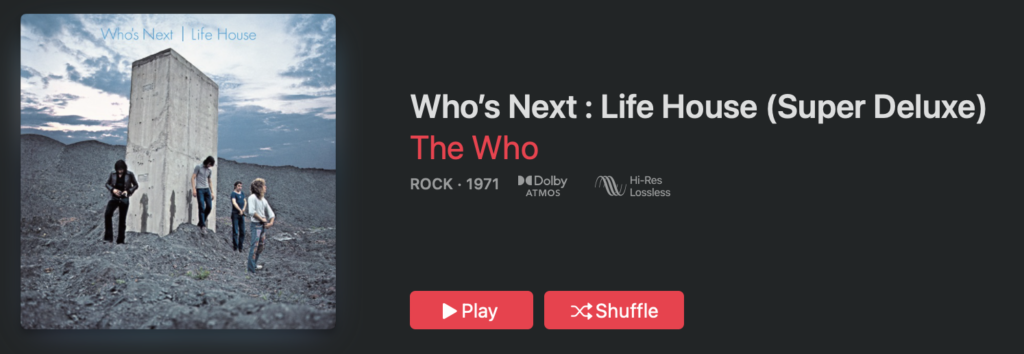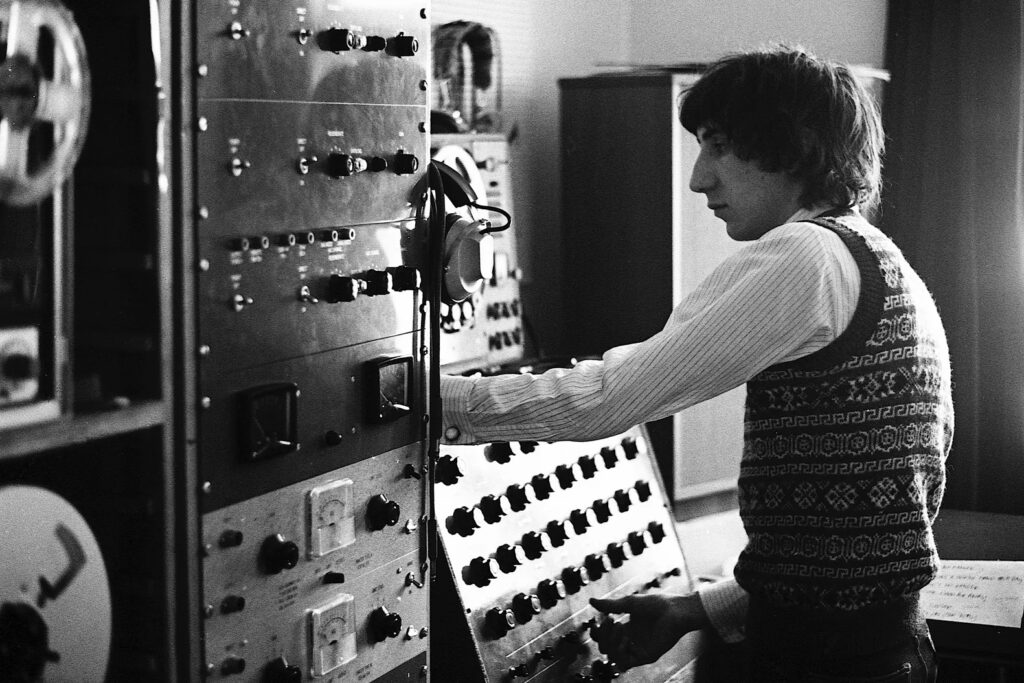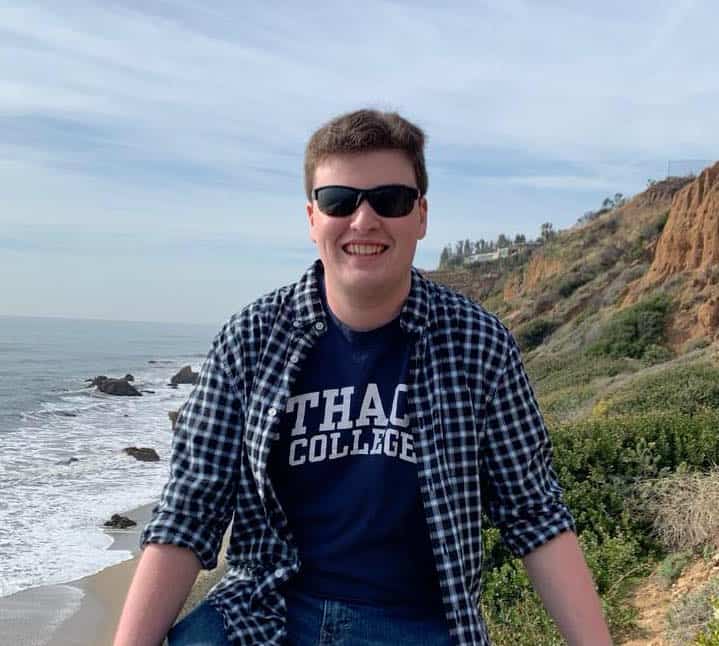In May 1969, The Who changed rock music forever with their fourth studio album; the groundbreaking conceptual rock opera Tommy. The world tour promoting Tommy lasted over a year, with the band giving nearly 200 live performances. 1970's Live At Leeds, often cited as one of the best live rock albums of all time, captured them at the height of their powers during this period.
Pete Townshend–The Who’s lead guitarist and principal songwriter–soon began work on an even more ambitious conceptual follow-up, Life House. The saga of Life House was to be set in the distant future, with Townshend’s early story treatments exploring concepts eerily similar to present-day technology like the internet and virtual reality.

Despite having already recorded a number of songs at The Record Plant studio in New York, internal tensions in the band ultimately led to Life House being abandoned by the Spring of 1971. That April, the band and producer/engineer Glyn Johns relocated to Olympic Studios in London to begin work on what ultimately became Who’s Next.
Though many of Townshend’s best compositions originally intended for the Life House project (“Baba O’Riley,” “Bargain,” “Love Ain’t For Keeping,” “Behind Blue Eyes,” etc) would form the basis of Who’s Next, others from the 1970-72 period would slowly trickle out in different forms throughout subsequent years. Some were issued as non-album singles ("Relay," "Join Together," etc), while others became part of the 1974 Odds & Sods compilation (“Pure and Easy,” “Naked Eye,” "Too Much Of Anything," etc).
The new Who’s Next / Life House Super Deluxe Edition will no doubt deliver the final word on this period of the band, including dozens of previously-unheard studio and live recordings from 1970-72 across a massive 11-disc box set. Additionally, Townshend’s story treatment of Life House has been translated into the form of a 172-page graphic novel.

The most exciting aspect of this reissue for audiophiles is undoubtedly the Blu-Ray disc containing brand-new stereo, 5.1 surround sound & Dolby Atmos remixes of the original nine-song Who’s Next album and fourteen(!) associated studio recordings by Steven Wilson. Though Wilson has remixed classic albums by the likes of Jethro Tull, Yes, Tears For Fears, and the Grateful Dead in immersive audio, this is among the most exciting and high-profile projects he’s been involved with to date.
Fans should note that nearly all of the Steven Wilson remixed material is truly exclusive to the Blu-Ray disc at this time, save for the original nine album tracks which can be streamed in Dolby Atmos from Apple Music, Tidal, and Amazon Music.
The Who’s Next / Life House Super Deluxe Edition was among my most anticipated immersive releases of 2023 not only because of Wilson’s involvement, but also for personal reasons–Who’s Next was among my Dad’s, and thus my own, favorite rock records of all time. He’d once described to me in detail the experience of first listening to the album on LP way back in 1971, on a friend’s pair of JBL-L100 speakers with the built-in bass & treble knobs ‘cranked to eleven’.

He claimed that the remastered "deluxe edition" carried by the streaming services–which didn’t impress me all that much, sounding kind of harsh and dynamically compressed–was a mere shadow of that original pressing he heard all those years ago, so I indulged him in a quest to locate a “perfect” LP copy of the album for our collection.
This past Spring, we happened across a mint original UK pressing (Track Record 2408 102) at a nearby vintage vinyl shop and eagerly set it up to play on our vintage stereo system (which features a Marantz 4070 console amplifier, Technics SL-1500 turntable equipped with an Audio-Technica AT440ML/OCC phono cartridge, and Polk Monitor 10B speakers from the early-1980s)–hoping to recapture the amazing experience he’d so passionately described.
When the full band comes “thundering in like a herd of buffalo” (as Glyn Johns so perfectly put it in the 1999 ‘Classic Albums’ documentary on Who’s Next) at about 45 seconds into “Baba O’Riley”, he was totally enthralled and excitedly said “this is how I remember it!”

As someone with much younger ears and different tastes as to what a ‘reference’ rock recording sounds like, what I heard was an improvement over past versions, no doubt, but not all that awe-inspiring nonetheless–it was a fairly noisy pressing, not the most dynamic recording in the world and maybe even a bit harsh in spots–but I could tell he was so excited that it was hard not to get wrapped up in the moment too.
The whole experience reminded me of something Chuck Ainlay told me last year, when I asked him about his work remixing Dire Straits’ classic 1985 album Brothers In Arms in 5.1 surround sound way back in 2005.
When it came time to do the 5.1 mix for the 20th anniversary, I wanted to keep the intent of the original recording yet also make it sound as “big” as I remembered. As the years go by, sometimes nostalgia colors your impression of these older recordings–but I wanted the surround version to recapture that feeling of when I first heard it.
My Dad had been interested in surround/immersive music since the days of quadraphonic vinyl & tapes in the early-1970s (our stereo setup includes both a working SQ decoder and CD-4 demodulator, two very obscure pieces of gear required to properly play back those special four-channel LPs) and always lamented that Who’s Next never received a proper remix in a multichannel format, be it 4.0 quadraphonic or 5.1 surround sound.
The idea of a surround sound Who’s Next was first floated by Pete Townshend way back in 2004, not long after he’d completed the excellent 5.1 remix of Tommy (issued on Super Audio CD and DVD-Audio), when he revealed–much to the disappointment of fans–that some of the album’s original multitrack assets were missing, precluding a remix for the foreseeable future. The three affected songs were later confirmed to be “Bargain,” “Getting In Tune,” and “The Song Is Over.”
I couldn't have imagined that my Dad would unexpectedly pass away from a stroke on September 2nd, at the age of 68–a mere two weeks before the box set and Atmos mix would be released. So listening to this fantastic reimagining of a classic for the first time was a strangely bittersweet experience, knowing I’ll never get to share it with him or hear his thoughts on it.

Though Who’s Next is perhaps not as densely-layered as other albums from this era that Steven Wilson has remixed in 5.1 surround or Dolby Atmos, such as King Crimson’s Lizard (1970) or Yes’ The Yes Album (1971), I think he’s nonetheless made the most of the limited (by today’s standards) original multitrack recordings to craft an exciting new immersive experience chock full of detail yet also faithful and respectful to the original production.
In July 2022, he revealed to us a number of tantalizing details about the project. It seems that the complete multitrack master for "Getting In Tune" was eventually located, but the same cannot be said for "Bargain" and "The Song Is Over."
There's one song that was missing altogether, “Bargain,” which is an upmix. Then, with “The Song Is Over,” one of the slave reels with the synthesizer parts and vocals was missing. We were able to extract the vocals using software, and Pete re-recorded all the ARP 2600 parts phenomenally well. I’m hard to impress with these things, but he did it in a way I think the fans will be extremely pleased with. Of course, the alternative would be just to not mix it.
I was kind of skeptical at how impressive “Baba O’Riley” could be in surround sound, given the economical nature of the original recording. The aforementioned ‘Classic Albums’ documentary revealed that the entire backing track (drums, bass, piano, and electric guitar) was confined to a stereo pair on the eight-channel master.
Despite that limitation, the Atmos mix of this song works remarkably well. As is so often the case with Steven Wilson’s remixing work, it somehow manages to retain the raw power of the original stereo presentation while also teasing out individual components in an exciting way. The iconic opening organ line swirls all around and above just as I’d hoped, while Roger Daltrey’s lead vocal is almost completely isolated in the center speaker.
The previously-mentioned stereo backing track is seemingly woven into all speakers at ear-level except for the center channel. The piano spans from front left all the way to rear left, though Townshend’s live guitar part that comes in at 1:40 seems mostly confined to the side right speaker. The short guitar solos at around 3:00 and 3:30 are mixed entirely to the height speakers, which was a fun surprise.
The upmix of “Bargain,” while definitely not as impressive as the other songs, does sound appropriately ‘big’ and fills out the room nicely. I didn't notice any artifacts from the Penteo software used by Wilson to create the pseudo-surround experience, though it does of course retain the murkier sonic quality of the original stereo presentation.
“Love Ain’t For Keeping” again keeps Daltrey mostly confined to the center channel, while the acoustic guitars are almost entirely isolated in the side speakers and background vocals are placed primarily in the rear heights. Moon's drum kit sounds like it was recorded to a single mono track for this song, but sounds thunderous and room-filling from the front center position nonetheless.
I imagined Wilson would do something fun with the horn parts in “My Wife” and I’m not disappointed: they come screaming from the rear surround speakers, while Townshend's guitar swells swirl all around the height channels. John Entwhistle's double-tracked lead vocals were originally spread left-to-right, but now they're divided front-to-back between the center & rear speakers to great effect.
I wasn’t personally bothered by the re-recorded elements in "The Song Is Over," but if one were to closely A/B with the original stereo I imagine there would be a detectable difference. The Atmos mix of this track was nonetheless amazing, particularly the ending passage where the drums roll all around the surround field and Townshend & Daltrey’s vocals (“there once was a note…”) alternate between the front & rear height speakers.

I’ll additionally note that the lead vocals throughout "The Song Is Over" sound superbly clear to my ears, exhibiting none of the maladies sometimes associated with consumer-grade ‘de-mixing’ software packages like Izotope’s RX Music Rebalance or Deezer’s Spleeter. It’ll be interesting to see how this kind of stem separation/extraction technology continues to evolve in the coming years.
“Getting In Tune” kicks off with the piano in the side right speaker, while the electric guitar appears centered in the rears–directly behind the listener’s head. The backing vocals (“getting in tune on the straight and narrow…”) wildly swing between the rear height speakers. “Going Mobile” again makes heavy use of the side speakers for acoustic guitars, with the ARP synthesizer filling up the rear surrounds and crazy wah-wah guitar isolated in the rear left height speaker.
The one track that didn't perfectly stick the landing for me was perhaps my favorite on the record, "Behind Blue Eyes.” The cathedral-like ambience during the acoustic intro section is perfect, but the vocal harmonies–now relocated to the rear surround speakers–felt much louder and drier than in the original stereo, to the point where they seem a bit overexposed.
Nitpicks aside, there are definitely some fantastic moments in that great song–like when Townshend’s harmony vocals on specific lines (“I blame you” and “can show through”) pop up in the front heights, directly above Daltrey’s lead in the center. Plus, the enhanced dynamic contrast between the mellow opening passage and full band entrance at 2:20 adds even more emotional power and impact.
“Won’t Get Fooled Again” was always frustrating on the old LP pressings, prone to inner-groove distortion and lacking low-end (in my opinion, at least) in comparison to the rest of the album. While this is much cleaner and more impactful than any prior version I’ve heard, it does nonetheless still seem to be missing some of the low-frequency ‘punch’ found in the other songs. Perhaps this is due to the recording having taken place at the Rolling Stones Mobile in Stargroves rather than Olympic?
However, unlike the rest of the album tracks, "Won't Get Fooled Again" was captured using a 16-track tape machine–making the scope for the new immersive experience that much greater. Keith Moon’s ferocious drums thunder across the front soundstage, while Townshend’s acoustic guitar emanates primarily from the left side surround. The iconic choppy synthesizer line, previously confined just to the right channel in the stereo, now slowly floats from side-to-side like waves crashing in the ocean.
Backing vocals (“I tip my hat to the new constitution…”) again pop out of the rear heights, and the handclaps bouncing all around & above during the instrumental break before “I move myself and my family aside” was perfect. The Atmos experience is akin to being inside a chaotic whirlwind of instrumentation, yet there is a newfound clarity and focus to each part in a way that wasn't previously apparent.

For those who haven't yet made the leap to Dolby Atmos and still inhabit the world of traditional discrete six-channel surround sound, fear not as the DTS-HD 5.1 mix also makes for a fabulous listening experience. Note that this is not a ‘fold-down’ of the Atmos presentation, but rather a completely unique mix intended specifically for a 5.1 array.
Many of the elements that appear isolated in the side surround speakers–such as the acoustic guitars in “Love Ain’t For Keeping”–instead hover in the ‘phantom’ spaces between the front & rear channels in the 5.1 mix.
Another interesting difference is in “Baba O’Riley”–whereas the Atmos mix had the electric guitar in the height speakers and fiddle in the rear surrounds, the 5.1 version instead positions the guitar in the back speakers and fiddle in the center channel.

Moving into the bonus portion of the Blu-Ray, "The Seeker" kicks off with Townshend's electric guitar blasting away in the front left speaker while an acoustic part pops up in side right and harmonies fill out the rears. The backing vocal 'oohs' starting in the second verse interestingly appear mostly in the front right height channel.
Similar to "My Wife," the double-tracked vocals in "Pure and Easy" have been creatively re-positioned front-to-back for the 5.1 & Atmos mixes. Keith Moon's drums are amazingly clear throughout this song, as if they're being played in the room. The ending passage where Townshend and Daltrey trade lead vocals ("there once was a note...listen") is particularly entertaining: both parts share the center speaker, but their doubles are hard-panned in the back corners (Townshend in rear left, Daltrey in rear right).
"Naked Eye" is another standout, kicking off with studio chatter in the rear heights and acoustic guitar & piano hard-panned into the side surrounds. The heavy guitar line after "...don't happen that way at all" comes screaming out of the rears, while the end guitar solo floats gracefully around the height speakers in a clockwise motion.
I could try to eloquently conclude my thoughts on this fabulous new immersive remix of an album I've long loved, but Steven Wilson himself sums it up best in his short essay included in the box set's liner notes.
For me, the economy inherent in the recording process of Who's Next actually makes for a really engaging surround experience. You can hear the space between all the instruments, every gesture in the music. Even the sound of the room they were recording in. Both compositionally and performance-wise nothing on Who's Next is superfluous or wasted, everything counts. It's almost a cliche with surround sound to say that it's like you're in the studio with the band, but that really is the way it feels on these iconic recordings. You can almost reach out and touch the music.
As far as surround/immersive remixes of classic albums go, in my view it simply doesn't get much better than this. Was it worth the high price of admission? I wouldn’t call it a bargain by any means, but–based on the joy that the Blu-Ray disc alone has brought me thus far–the answer is a resounding "yes." I only wish that my Dad was still here to enjoy it with me.

